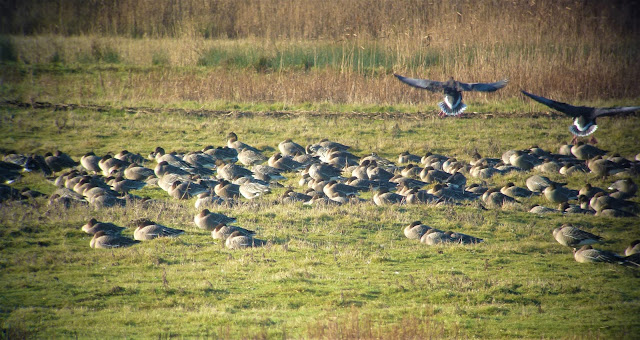Honeyguide’s first ever local guided walk was at Potter Heigham Marshes, and a weather forecast suggesting sunshine prompted a return visit. The reality was a very misty start to the day, with the sun looking more like a full moon first thing, though happily the day became steadily brighter.
Potter Heigham Marshes is usually a good place for birds and so it proved as soon as we were overlooking the grazing marshes, with the backs of riverside chalets behind us. A crow on the grass and rooks on wires were followed by three gull species, for easy comparison: herring, black-headed and common gulls, the last with a ‘kind face’, as Chris A noted. More on common gulls later. The nearby lapwings were looking very smart, a male with his long fascinator-style crest. A little egret flew through, and two snipe dashed away.
Moving on, a flock of 70 or so pink-footed geese
flew over, then returned in the other direction. Arriving at the lagoons area
there were more geese, namely a group of greylags and Canada geese with a
single pink-footed goose, this time on the grass. Out on the first lagoon were
tufted ducks, a single shoveler and shelduck and a scattering of teals. Soon
there were many more of all of these, plus plenty of wigeons and a few
gadwalls. Teal as a colour is often described as a blue, though in the sunshine,
now out, the ducks’ flash today seemed more like a shiny green.Bank vole (Helen Crowder).
Three of us then realised that the other three had lagged behind and with good reason: they had found a bank vole by the edge of the path. And very cute it was too, from Helen’s picture.
Farther along there were many more ducks, shovelers and shelducks especially, plus good numbers of cormorants. A lone small wader proved to be a dunlin. A Cetti’s warbler gave a burst of song and a marsh harrier quartered the reedbed.
 |
| Shelducks, shovelers and lapwings, plus two gadwalls if you look carefully. |
 |
| Cigar gall on reed. |
We’d reached the return home straight, albeit a long one, when a great white egret flew past us. Just a couple of years ago it would have been a red-letter day to see one of these, and already it’s almost a routine sighting. Could we top this? Yes: a green sandpiper on a small flood in the field, actually looking green in the sunshine – so often they are more black-and-white.
Yet today’s star birds proved to be a more every-day species. Two common gulls by the green sandpiper started to display, running alongside each other, heads down, then threw their heads in the air, calling together. It felt like a bright winter’s day to us, but perhaps it was the first day of spring for them.
 |
| Common gulls displaying (digiscoped collage). |
 |
| Common gulls, heads aloft (digiscoped). |
Chris Durdin

























